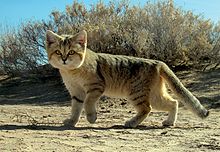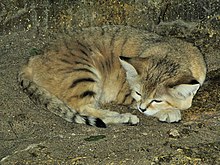From Wikipedia, the free encyclopedia
The sand cat (Felis margarita), also known as the sand dune cat, is the only cat living foremost in true deserts. This small cat is widely distributed in the deserts of North Africa, the Middle East and Central Asia. It was listed as Near Threatened on the IUCN Red List since 2002 because the population was considered fragmented and small with a declining trend. It was downlisted to Least Concern in 2016.
The sand cat inhabits both sandy and stony desert, in areas far from water. Having thickly furred feet, it is well adapted to the extremes of a desert environment and tolerant of extremely hot and cold temperatures.
...
The sand cat is a Felis species, a genus within the family Felidae. The French soldier and naturalist Victor Loche first described the sand cat from a specimen found in the area of "Négonça" in the northern Algerian Sahara, and proposed to name the cat in recognition of Jean Auguste Margueritte, who headed the expedition into the Sahara. This holotype specimen appears to have been lost.
In 1926, Russian zoologist Sergej Ognew described a sand cat collected in the Karakum Desert in Turkmenistan under the name Eremaelurus thinobius. In 1938, British zoologist Reginald Innes Pocock considered this specimen as a species under the name Felis thinobius. Later he considered it a subspecies of the sand cat, which to date is widely recognised.
The sand cat's fur is of a pale sandy ocherous color. Markings vary between individuals: some have neither spots nor stripes, some are faintly spotted, some have both spots and stripes. There are blackish bars on the limbs, and the tail has a black tip with two or three dark rings alternating with buff bands. It is a small cat characterised by a flat, wide head, short legs and a relatively long (23 to 31 cm (9.1 to 12.2 in)) tail. It reaches 24–36 centimetres (9.4–14.2 in) at the shoulder and weighs 1.5–3.4 kilograms (3.3–7.5 lb). The head-and-body length ranges from 39 to 52 cm (15 to 20 in). The 5–7 cm (2.0–2.8 in) long ears are set low, giving a broad flat appearance to the head. They are tawny at the base and tipped with black, and more pointed than those of Pallas's cat. The pinnae of the ears are triangular, and the ear canal is very wide, giving the cat an enhanced sense of hearing. The auditory bullae and the passages from the external ears to the ear drums are greatly enlarged relative to other small felids; the inner parts of the ears are protected from foreign objects by long, closely spaced white hairs. The large, greenish yellow eyes are ringed with white, and the nose is blackish. The head is sandy brown, whereas the lower and upper lips, chin, throat and belly are white. In some individuals, the throat has a hint of buff. The lower part of the face is whitish, and a faint reddish line runs from the outer corner of each eye across the cheeks. Its whiskers are white and up to 8 cm (3.1 in) long.
In northern regions, the sand cat's winter coat is very long and thick, with hairs reaching up to 2 in (5.1 cm) in length. The sand cat’s claws on the forelimbs are short and very sharp, the ones on the hind feet are small and blunt. The undersides of the paws are protected from extreme temperatures by a thick covering of fur.[18] The long hairs growing between its toes create a cushion of fur over the foot pads, helping to insulate them while moving over hot sand. This feature makes the cat's tracks obscure and difficult to identify and follow. The sand cat has a bite force quotient at the canine tip of 136.7,
Distribution and habitat
The sand cat is found primarily in both sandy and stony desert and has a wide but apparently disjunct distribution through the deserts of northern Africa and southwest and central Asia. It prefers flat or undulating terrain with sparse vegetation, avoids bare sand dunes, where there is relatively little food. It can survive in temperatures ranging from −5 °C (23 °F) to 52 °C (126 °F) and retreats into burrows during extreme conditions. Although it will drink when water is available, it is able to survive for months on the body fluids in its prey.[19]
In North Africa, the sand cat occurs marginally in western Morocco, including former Sahara Occidental, in Algeria, and from the rocky deserts of eastern Egypt to the Sinai peninsula. Sightings have been reported from Tunisia, Libya, Mali and Niger. In Mauritania, it probably occurs in the Adrar mountains and the Majabat al Koubra. Spoor has been found in Senegal, Chad, and Sudan.
In the early 1990s, several sand cats were radio-collared in southern Israel. In the late 1990s, sand cats were also recorded in Jordan. Sand cats were sighted and camera trapped in a protected area near Palmyra in Syria in 2000 and 2001. In 2012, sand cats were recorded for the first time in Iraq, in the Al Najaf desert.
In central Asia, the sand cat occurs east of the Caspian sea throughout the Karakum Desert from the Ustyurt Plateau in the northwest to the Kopet Dag Mountains in the south extending through the Kyzylkum Desert to the Syr Darya River and the northern border to Afghanistan.
Ecology and behavior[edit]
Sand cats live solitary lives outside of the mating season. They communicate using scent and claw marks on objects in their range and by urine spraying. They do not leave their feces in exposed locations as many other felids do. They make vocalizations similar to domestic cats but also make loud, high-pitched barking sounds, especially when seeking a mate. Hearing plays an important role in intraspecific communication; sand cats make a short, rasping bark in connection with mating activity.
They inhabit burrows and use either abandoned fox or porcupine burrows or enlarge those dug by gerbils or other rodents. The burrow is about 1.5 m (4.9 ft) deep and dug in slightly slanting ground with usually only a single entrance, though burrows with two or three entrances have also been observed. In winter, they stay in the sun during the day, but during the hot season, they are crepuscular and nocturnal.[6]
Their way of moving is distinct: with belly to the ground, they move at a fast run punctuated with occasional leaps. They are capable of sudden bursts of speed and can sprint at speeds of 30 to 40 km (19 to 25 mi) per hour.[26] During a radio telemetry study in Israel, sand cats were found to have large home ranges, with one male using an area of 16 km2 (6.2 sq mi). They have been recorded to move long distances of 5–10 km (3.1–6.2 mi) in a single night and were generally active throughout the night, hunting and travelling an average of 5.4 km (3.4 mi). Before retiring below ground at dawn, the observed cats adopted the same lookout position at the mouth of the burrow. Different cats used burrows interchangeably and did not change burrows during the day.
Small rodents are their primary prey, with records from Africa including spiny mice, jirds, gerbils, jerboas, and young of cape hare. They have also been observed to hunt small birds like greater hoopoe lark, desert lark, and consume reptiles such as small desert monitors, fringe-toed lizards, sandfish, short-fingered gecko, horned and sand vipers, and insects. They are capable of satisfying their moisture requirements from their prey but drink readily if water is available. They can dig rapidly to extract their prey from the ground and bury prey remains in the sand for later consumption.
Reproduction and life cycle[edit]
Oestrus in sand cats lasts from five to six days and is accompanied by calling and increased scent marking. An average litter of three kittens is born after 59 to 66 days, typically around April or May, although in some areas, sand cats may give birth to two litters per year. The kittens weigh 39 to 80 grams (1.4 to 2.8 oz) at birth, with spotted pale yellow or reddish fur. They grow relatively rapidly, reaching three quarters of the adult size within five months of birth. Sand cats are fully independent by the end of their first year and reach sexual maturity not long after.
Of 228 sand cats born in zoos globally to the year 2007, only 61% lived to day 30. They died primarily due to maternal neglect by first-time mothers. They can live up to 13 years in captivity. The life expectancy of sand cats in the wild has not been documented.
Threats[edit]
Habitat degradation is the major threat to the sand cat. Vulnerable arid ecosystems are being rapidly degraded by human settlement and activity, especially livestock grazing. The sand cat's small-mammal prey-base depends on having adequate vegetation, which may experience large fluctuations due to drought or declines due to desertification and loss of natural vegetation. They also may be killed in traps laid out by inhabitants of oases targeting foxes and jackals or in retaliation for killing their chickens. There are occasional reports of animals shot in southeast Arabia.[2]
In Israel, sand cats were thought to be endangered by predation of larger carnivores such as caracals, wolves and, of those who venture close to human settlements, dogs.
Conservation
Felis margarita is listed on CITES Appendix II. Hunting is prohibited in Algeria, Iran, Israel, Kazakhstan, Mauritania, Niger, Pakistan and Tunisia. No legal protection exists in Egypt, Mali, Morocco, Oman, Saudi Arabia, and United Arab Emirates. Previously having been classified as Near Threatened, it has been downlisted to Least Concern in 2016, as the estimated size of the global population exceeds the threshold for a threatened category; the extent of decline of the global population is unknown.
The Jerusalem Biblical Zoo started a sand cat reintroduction project in Israel's Arava Desert. Several captive-born individuals from the zoo's population were kept in an acclimatization enclosure but did not survive subsequent release into the wild.
In captivity
Captive sand cats are highly sensitive to respiratory diseases and infection of the upper respiratory tract. This is the main cause of death in adults. The most common disease is infectious rhinotracheitis. With sand cats being very susceptible to respiratory infections, they have to be kept in very arid enclosures where humidity and temperature do not fluctuate.
As of July 2009, the global captive population comprised 200 individuals in 45 institutions. As of May 2010, 29 sand cats were kept in 12 Association of Zoos and Aquariums-accredited institutions participating in the Species Survival Plan. In January 2010, the Al Ain Zoo announced the first success of an in vitro fertilisation and embryo transfer procedure on sand cats, resulting in the birth of two kittens at its facilities.In July 2012, four sand cat kittens were born at the Ramat Gan Zoo as part of the European Endangered Species Programme.






No comments:
Post a Comment